Authentic local salsa made in Virginia
What a happy zingy way to eat your veggies!
– By the Veggie Fairy Team
She was born in Venezuela. Her parents named her America. Later she married Lionel, who comes from Mexico, and she grew to love the flavors of his rich culture. So, no surprise that she’s now handcrafting authentic local salsas and Latin sauces right here in Virginia, right?
The company is Salsas Don Sebastian, which is named after their son Sebastian.
We veggie fairies were all a-twitter when all those amazing salsas made their debut in our home-delivered farmers market. We weren’t the only ones — our members couldn’t get enough of it. Salsa is a delicious mix of fresh vegetables, and that makes it an easy, yummy way to boost your veggie intake. So we had to get the story on this new local salsa that was lighting up our taste buds.
VEGGIE FAIRY:
Did you grow up eating salsas?
AMERICA:
Not like this! I got really into salsas after several trips to Mexico, where I was introduced to a wide range of flavors and colors that I was not used to before. I learned that in Mexico, there is a salsa for everything. Mexicans use it as a complement for every dish. As I started tasting salsas, my tolerance of the spices and heat was low. Now, however, I feel like I can actually taste the flavors of the different peppers that are used in the different salsas.
VEGGIE FAIRY:
How did you make the leap from making it for your family to making it for everyone?
AMERICA:
I have this vein of being independent and intrepid. I love doing something fun, different, creative. We’d been making the salsa forever, mainly because we couldn’t find any authentic Mexican salsas in the market. None of those products were as fresh and filled with exciting flavors as what we were making at home. So, from out of the blue it occurred to me that we might have something here that other people might enjoy. I talked about it with Lionel, but he had a good corporate job and he said, “I’m not going to leave my job to make salsa.” So I said, “Teach me!” Two years later, I quit my job teaching Spanish throughout the Richmond metro area and the rest is history.
VEGGIE FAIRY:
Making food like this is a very creative process, right?
AMERICA:
It is! I discovered it was even more creative than I thought. You don’t just throw things in the blender. Making it is a science and an art, finding the balance among all the ingredients. Different salsas use different ingredients, and since I use as many locally grown ingredients as possible, they change with what’s in season. So I started making salsa and giving it away and people said, “I’d buy this in a heartbeat.” I put up a post on our Facebook neighborhood page and said, “Hey guys I’m thinking about selling this at a farmers market, would you try some? I just need feedback.” Lots of people wrote back saying they wanted to try it. I distributed it around and it was amazing — all the feedback was positive.
VEGGIE FAIRY:
What did your taste-testers like best?
AMERICA:
Everyone talked about how fresh it was. What I make is very different from other salsas in the grocery store. Read the ingredients and those industry-made salsas have sugar and preservatives. They’ve been shipped from who knows where and then sit on the shelf for who knows how long. I make salsa today and the next day it’s on your shelf.
VEGGIE FAIRY:
I didn’t realize there was sugar in the big industry-made salsas.
AMERICA:
Mine has no added sugar. There are plenty of natural sugars in fresh vegetables. My salsas are also gluten free. And not to mention delicious! We make every batch from the freshest ingredients available that we can find locally. That’s why our salsas are fresher and tastier — because they’re local.
VEGGIE FAIRY:
What do you look for in the produce that goes into what you make?
AMERICA:
I go to different farmers markets and I have made very valuable relationships with the local farmers there. When local produce is in season, I source from my friends who farm sustainably. When my must-have ingredients aren’t in season, then I go to my regional wholesaler. Either way, it has to be fresh and it has to be grown sustainably. That’s good for us and for the environment. And I help make sure nothing goes to waste, because most of my produce doesn’t have to look perfect. I’m cutting it up. It just has to taste perfect.
VEGGIE FAIRY:
Yeah, we love ugly food, too! So long as it’s fresh and local, it has more taste and nutrients than the pretty produce in the grocery store.
AMERICA:
Exactly. Like the tomatoes I use don’t need to look perfect and the farmers love me for that. The only exception is cilantro. It has to be beautiful and green and perfect because that pop of color is part of what makes salsa so irresistible. But jalapenos, for example, they just need to be hot!
VEGGIE FAIRY:
How do you, the professional, use salsa?
AMERICA:
On everything! Our red salsa is so versatile that it goes with most meats. You can put it on eggs, or just enjoy it as a dip with fresh chips or tostadas.
VEGGIE FAIRY:
So who does what at Salsas Don Sebastian?
AMERICA:
I wear most of the hats. My sister helps me with prepping all the veggies and making sure that all vegetables are super clean. Lionel helps when he gets in from work and also sells in farmers markets on the weekends. We work from the same recipes that his grandmother used when he was growing up. So every batch we make reminds him of fond memories from his childhood. Flavors and aromas are very connected to memory and we’re handcrafting happy new ones for our customers every day with our salsas.
*
Start making your own delicious memories with America’s salsas and Latin sauces. You’ll find them in the Seasonal Roots home-delivered farmers market every weekend. In between you can check out all her latest creations on the Salsas Don Sebastian website and on Facebook.
ABOUT SEASONAL ROOTS
Since 2011, Seasonal Roots’ online farmers market has connected Virginia families with local family farmers who use sustainable, humane practices. Our veggie fairies – mostly moms who believe in living better through scrumptious, healthy eating, being kind to animals, protecting the environment, and spreading joy – home-deliver freshly harvested produce, pastured eggs, grassfed dairy and meat, plus artisan fare. We empower our members to eat better and live better with more nutritious, flavorful food that’s good for us and good for the planet. More info at seasonalroots.com.


































